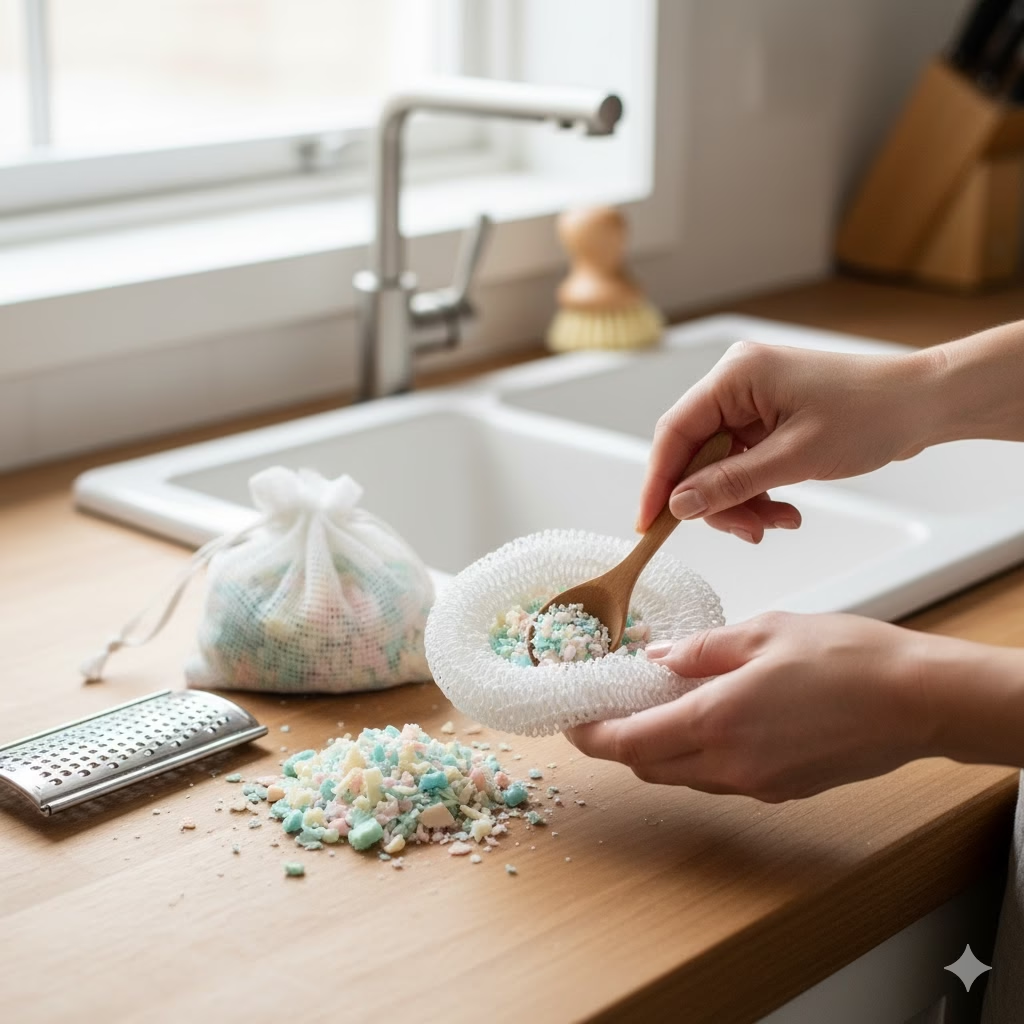
Ever feel like life’s just getting too big, too fast? I know the feeling. I used to dream of a simpler existence, one that was kinder to my wallet and the planet, without sacrificing an ounce of personal style and build tiny. That’s when I stumbled upon the captivating world of tiny homes, and it completely reshaped my perspective on what “home” truly means. Join me as we delve into the art of creating extraordinary tiny living spaces, starting right from the outside in.
Think Big, Build Tiny: Exterior Designs That Defy Expectation
Tiny homes are now much more than a fleeting trend. They show a big change in how we view where we live. For many people, though, a “tiny home” still looks like a basic, boxy structure. It seems practical, but not inspiring. This article will smash that idea. We’ll look at incredible exterior designs that turn simple homes into works of art. Living small doesn’t have to mean thinking small. We will see how good design, green practices, and bold creativity lead to beautiful tiny homes. These homes look great and treat our planet kindly.
Build Tiny: It’s More Than Just Walls

The true magic of tiny home exterior design comes from one basic idea: every inch matters, both inside and out. It’s not about stuffing things into a small place. It’s about making sure every part does three jobs: look good, work well, and help the environment.
When you Think Big, Build Tiny, you question what a home should look like. You embrace new ideas to create a place that is both a private retreat and a strong statement.
This mindset works in several key ways:
- Using Space Wisely: The outside design is just as important as the inside. It controls how much natural light enters. It creates usable outdoor “rooms.” It also makes the house feel bigger.
- Fitting In With Nature: Tiny homes often try to feel like part of the landscape. Exterior design is vital for helping a home blend in or stand out in a smart way.
- Green Design is Style: Earth-friendly choices are not just about materials. They are about complete systems that work together. These features—like rain collectors, solar power, and living walls—are often visible. They are a core part of the look.
Build Tiny: Cool Shapes and Forms
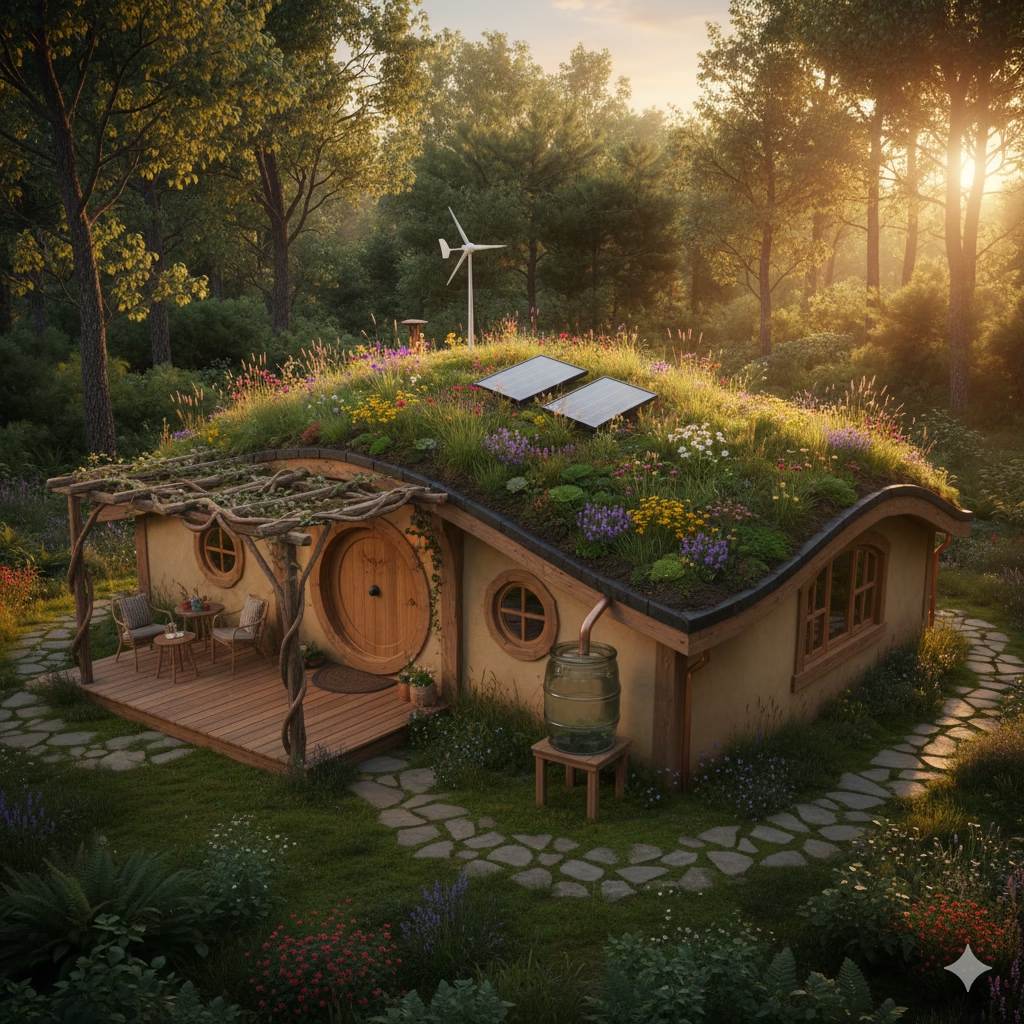
The classic tiny home built on a trailer is useful, but today’s designers are using new, exciting shapes. These designs grab your attention. They often offer practical benefits, too. These can include better aerodynamics, less energy use, or unique room layouts.
Examples:
- Geodesic Domes & A-Frames: These shapes are naturally strong. They are great at keeping heat in or out. Their unique, fun look makes them distinct. A steep A-frame roof easily sheds snow and rain. A dome shape minimizes the outside surface area while giving maximum space inside.
- Curved Walls & Natural Shapes: Some tiny homes use rounded walls. Builders often make these walls with methods like straw bale or cob. This creates a softer, more natural look that feels linked to the earth. These forms can also cut down on wind resistance.
- Homes That Grow: Some tiny homes are built in parts. Exterior parts can be added or moved. This offers great flexibility and a changing visual look.
How to Do It:
Don’t be afraid of an unusual shape. Look into the structural needs of unique forms. For curves, you can use flexible building supplies like bendable plywood. You can also try natural building methods like cob. If you plan to build far outside a standard rectangle, hire a designer who knows how to work with unique structures.
Materials That Matter: Eco-Friendly and Beautiful
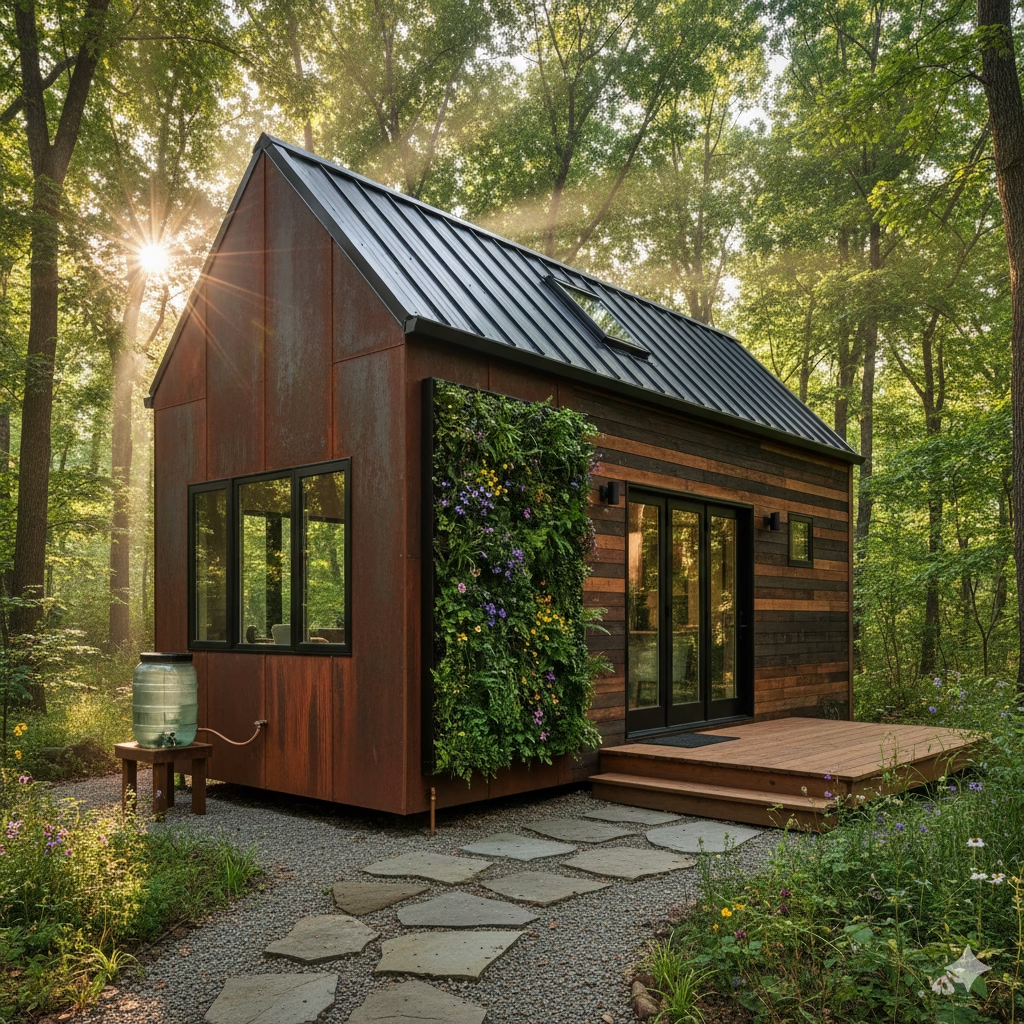
The outside siding is a tiny home’s skin. It shields the home from the weather and defines its style. Choosing materials that are green, tough, and nice to look at is key for a long life and for protecting the planet.
Examples:
- Reclaimed Wood & Old Barnwood: This material gives a cozy, rustic feel. It has unique character. Using it keeps waste out of dumps. The weathered look of reclaimed wood tells its own story.
- Metal Siding (Corten Steel, Standing Seam): This material lasts a long time. It needs little care and can be recycled. Corten steel gets a protective layer of rust, giving it a modern, industrial style. Standing seam metal roofs are perfect for collecting rainwater.
- Cedar Siding & Shingles: Cedar resists rot naturally and looks beautiful. It turns a lovely silver-gray color as it ages. If you get it from managed forests, it is a sustainable choice.
- Fiber Cement Siding: This is tough, resists fire, and requires little maintenance. It can look like wood, stone, or stucco. Many brands now use recycled content in their products.
- Living Walls & Green Roofs: These are not just nice to look at. They add insulation, clean the air, manage rainwater, and help local wildlife. A green roof helps control the inside temperature. This means you use less energy.
How to Do It:
Focus on materials that need little energy to make and move. This is called low embodied energy. Buy materials locally to lower your carbon footprint. Study how well the material insulates (R-value) and how long it will last. Mix different materials for a varied look and feel. For living walls, plan for watering and choose plants that suit your area.
Windows: Eyes to the World and Smart Design

Windows do more than bring in light. They are vital to a tiny home’s curb appeal and energy use. Placing and sizing them well can completely change how a home looks and feels inside.
Examples:
- Large Picture Windows: They give you great views, bringing the outside in. This makes the inside feel much larger. They are great for natural solar heat in cold places if they face south.
- High (Clerestory) Windows: Placed high up on a wall, these let in natural light while keeping your privacy. They also help with airflow. They can highlight unique roof shapes.
- Opening Windows & Folding Doors: These choices maximize fresh air flow. They connect the inside and outside perfectly. This actually makes your living space bigger when the weather is nice.
- Skylights: These flood lofts with light. They are also fun for looking at stars. Make sure they are energy-efficient and properly sealed to stop leaks.
How to Do It:
Think about your local climate. For natural solar heating, place bigger windows toward the sun (south in the Northern Hemisphere). For cooling, you need opposing windows to get cross-ventilation. Always choose top-quality, double or triple-paned windows. Look for low-emissivity (Low-E) coatings. These reduce heat transfer. Think about the views the windows frame and how to maintain privacy.
Maximizing Outdoor Living: Decks, Porches & Awnings

A tiny home’s outdoor space often becomes another room. Smartly designed outdoor features expand the living space. These parts not only make the home more useful but also boost its looks and make it seem bigger.
Examples:
- Fold-Down Decks & Porches: These are clever solutions for tiny homes on wheels. They add a living area without increasing the size for travel. When set up, they create a welcoming entrance and sitting area.
- Retractable Awnings & Pergolas: These provide shade and shelter. They let you use your outdoor spaces more often. Awnings can be pulled back to let in solar heat during winter.
- Built-In Storage & Seating: If built into the outside, these items can serve two roles. They create useful outdoor zones.
- Outdoor Showers & Cooking Nooks: If you love the outdoors, these features further blur the line between inside and out.
How to Do It:
Design based on your local weather. If it’s hot, focus on shade. If it’s mild, focus on open-air comfort. Use tough, weather-proof materials like treated wood or recycled plastic decking. For fold-down features, ensure strong hinges and secure locks. Think about how these parts will look when they are both open and put away.
Build Tiny: Yard and Site Work
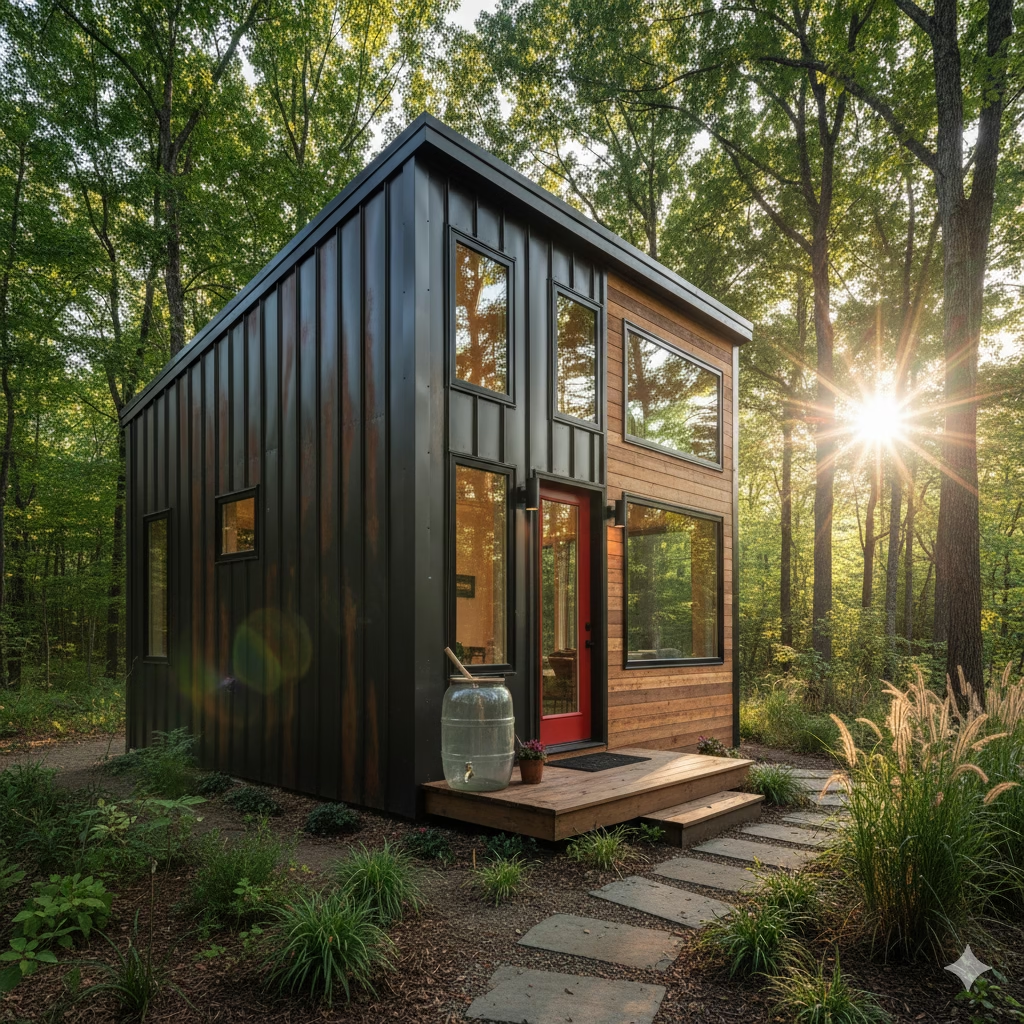
The area right around a tiny home is a continuation of its design. Careful landscaping and blending with the site are key for both beauty and sustainability.
Examples:
- Local Plant Landscaping: Use plants that are already suited to your climate. They need less water and care. They also support local wildlife. This helps the home fit naturally into its surroundings.
- Rain Gardens & Porous Paving: These features manage water runoff from storms. They prevent soil loss and refill groundwater. They are beautiful, useful landscape parts.
- Food Gardens & Herb Spirals: You can grow food right next to your home. This helps you be more self-sufficient.
- Smart Walkways & Lighting: These guide people and highlight important parts. They make the tiny home feel like a purposeful part of its location.
How to Do It:
Check your site’s weather, sunlight, and soil. Work with the land’s natural shape, don’t try to change it completely. Plan for water management right from the start. Think about how the plants will change with the seasons and over the years. For tiny homes on wheels, use potted plants or raised beds that can travel with the house.
The Power of Color & Texture: Visual Impact
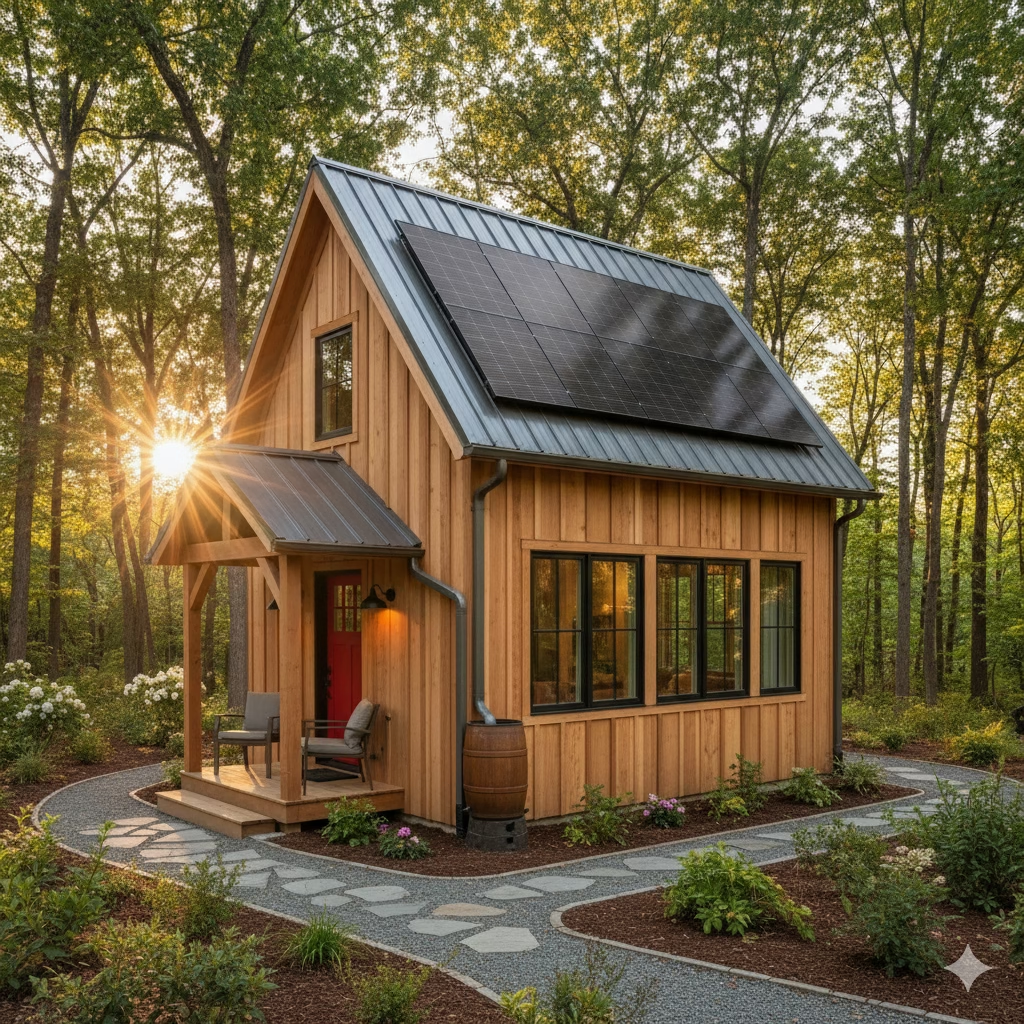
Color and texture are great design tools. They change how a tiny home looks and how it works with its setting. They can make a small building feel important, cozy, or perfectly matched to its site.
Examples:
- Contrasting Colors: A dark house with bright trim creates strong lines and highlights design details. A bold color on the front door adds character.
- Single-Color Schemes: Using one color family can make a tiny home feel bigger and more refined. This works well when you use varied textures, like smooth metal and rough wood.
- Natural Tones: Earthy colors like green, brown, and gray help a tiny home disappear into a natural area.
- Varied Textures: Combining smooth metal, rough wood, and maybe a stone feature adds depth and visual appeal. This stops a small house from looking too plain.
How to Do It:
Look at your setting. Is your home in a forest, by the sea, or in a city? Pick colors that either match or offer an interesting contrast to the area. Test paint samples under different light. Use texture to add warmth or a modern feel. Remember, lighter colors reflect light. This can keep the home cooler.
Integrated Sustainability: More Than Just Good Looks

Many green features add to the home’s look. However, some are purely functional and cleverly built-in. They truly show the spirit of “Think Big, Build Tiny.”
Examples:
- Solar Panels & Wind Turbines: These green energy sources are often visible. They are built onto roofs or stand alone near the house. Their presence clearly shows the home’s dedication to energy freedom.
- Rainwater Harvesting Systems: Gutters feed water into visible barrels or tanks. This becomes a design element. It shows the home’s efforts to save water.
- Composting Toilets & Greywater Outlets: These systems manage waste responsibly. They keep the environmental impact low.
How to Do It:
Plan for these systems early in the design process. Think about the weight and position of solar panels for the best sun. Check local rules for collecting rainwater and using greywater. Weave the collection spots and storage tanks into the exterior design. Maybe hide them with plants or pick tanks that look good on their own.
Case Study: The “Eco-Pod” Tiny Home
Picture a tiny home that belongs in a forest clearing. Its outside is covered in reclaimed cedar and a dark, metal roof. Part of the roof has a lively green roof full of flowers. This roof provides natural insulation and manages water. On the sunny side, large, efficient windows let in lots of passive solar heat in winter. A small, pull-out awning shades these windows in summer.
One wall has a built-in vertical living wall. It gets water from a hidden greywater system. A large rain barrel visibly catches water from the roof. It is linked to a small outdoor faucet for the garden. The entry is marked by a fold-down deck made of local composite material. It includes a built-in bench. This deck makes the usable space much bigger. It makes the tiny home feel much larger than its small base. The style is modern but rustic. It honors natural materials while using smart, green technology. It perfectly shows how to Think Big, Build Tiny: Exterior Designs That Defy Expectation.
Frequently Asked Questions (FAQ)
Q: Are tiny homes with unique exterior designs more difficult to insure?
A: Yes, sometimes. Standard insurers might hesitate. They prefer normal construction. You may need a specialty tiny home or RV insurance provider. Custom features like green roofs or unique shapes must be fully documented for a correct appraisal.
Q: Do unique shapes (like domes) cost more to build than a standard box?
A: Often, yes, the labor can be higher. While materials for a dome might be efficient, the specialized framing and custom-cut siding take more time and skill. A simple box is usually the cheapest to frame and clad.
Q: How do you make a vertical garden wall if you build tiny homes on wheels?
A: You need a lightweight, modular system. Use felt pockets or plastic trays attached to a light, durable frame. It must be strong enough to handle highway speeds. Use a separate, enclosed water tank for the greywater feed, if applicable, to prevent sloshing or leaks during transport.
Q: How can I ensure my reclaimed wood siding is durable and sustainable?
A: Buy from a certified local source to ensure quality and less transport. Check the wood’s moisture content. It should be treated with a non-toxic, eco-friendly sealant or oil. This protects it from bugs and weather.
Q: Does a metal roof really help with sustainability?
A: Yes, a lot. Metal is 100% recyclable at the end of its long life. Its light color can reflect sunlight (reducing heat gain). This cuts down on the need for air conditioning. It is also an ideal surface for collecting clean rainwater.
References
- dspace – LIVING TINY
- NREL – Passive Solar Technology Basics
Recent Posts


